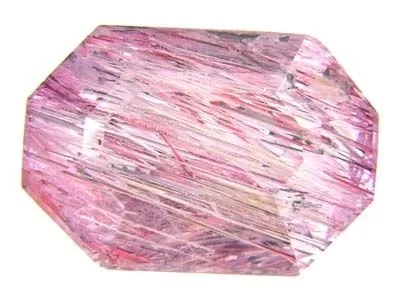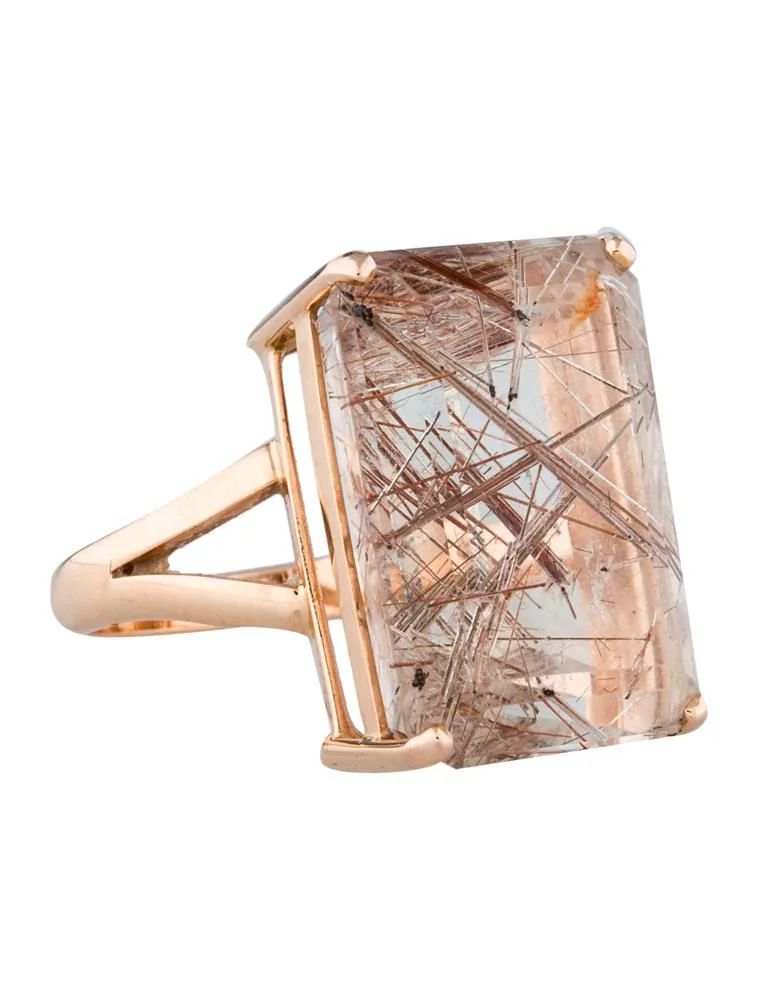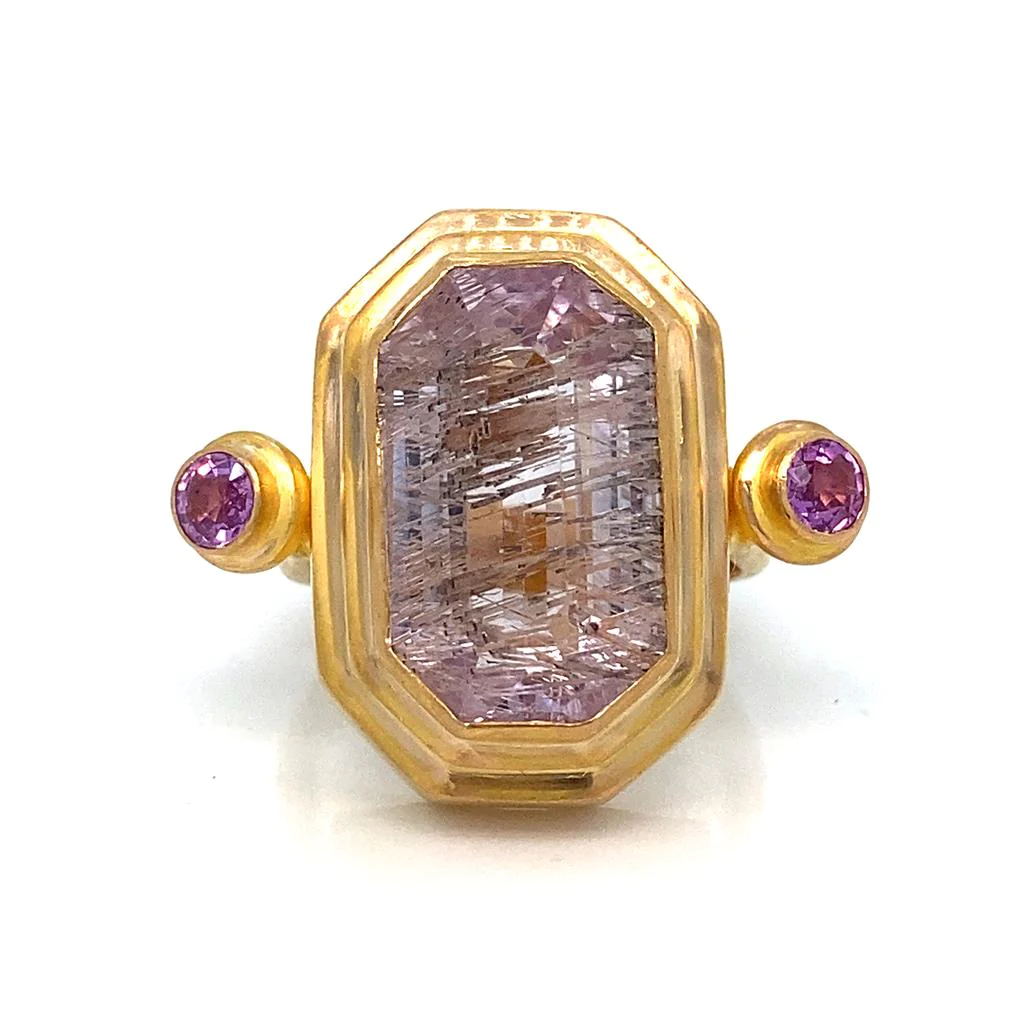Rutilated Kunzite is a unique and rare variety of the gemstone Kunzite that exhibits rutile inclusions within its crystalline structure. Kunzite itself is a beautiful pink to lilac-colored gemstone belonging to the spodumene mineral family, renowned for its delicate hues and exceptional clarity. The presence of rutile inclusions in Kunzite creates a mesmerizing effect, adding depth and character to the gemstone’s appearance.

Definition of Rutilated Kunzite:
Rutilated Kunzite refers specifically to Kunzite gemstones that contain needle-like inclusions of rutile. Rutile is a mineral composed primarily of titanium dioxide, often appearing as golden or reddish needles within other minerals. When rutile is present within Kunzite, it forms intricate patterns or streaks that enhance the gemstone’s visual appeal.
Brief History of Kunzite and its Discovery:

Kunzite was first discovered in 1902 by George Frederick Kunz, a renowned gemologist after whom the stone was named. Kunz was also responsible for identifying and naming several other gemstones during his career, earning him a prominent place in the history of gemology. Kunzite was initially found in the Pala District of San Diego County, California, USA. Its delicate pink to lilac hues captured the attention of gem enthusiasts and quickly gained popularity in jewelry design.
Explanation of Rutile Inclusions:
Rutile inclusions are thin, needle-like crystals of rutile that become trapped within the structure of other minerals as they form. In the case of Rutilated Kunzite, these rutile inclusions create captivating patterns within the gemstone, resembling fine golden or reddish threads. Despite being considered inclusions, rutile can actually enhance the gemstone’s beauty, providing visual interest and sometimes even increasing its value, especially when the inclusions are arranged in aesthetically pleasing patterns.
Geology and Formation

Kunzite is a variety of the mineral spodumene, which is a lithium aluminum inosilicate. It typically forms in lithium-rich pegmatites, which are coarse-grained igneous rocks found in mountainous regions. These pegmatites are formed from the cooling of magma deep within the Earth’s crust, often in association with granite intrusions. The presence of lithium, along with other elements and conditions during its formation, gives Kunzite its characteristic pink to lilac color.
The formation of Kunzite involves a series of geological processes including the crystallization of magma, fractional crystallization, and metamorphism. During crystallization, spodumene crystals form within the pegmatite veins as they cool. Over time, geological processes such as pressure, heat, and chemical reactions may alter the composition and appearance of the crystals.
Formation of Rutile Inclusions within Kunzite:
Rutile inclusions in Kunzite are formed during the crystallization process within the pegmatite. Rutile, which is composed primarily of titanium dioxide, can crystallize alongside Kunzite within the same geological environment. As the Kunzite crystals grow, rutile needles or crystals can become trapped within the spodumene structure, forming the distinctive needle-like inclusions characteristic of Rutilated Kunzite.
These inclusions can occur in various orientations and patterns depending on the specific conditions during crystal growth. The exact mechanisms behind the formation of rutile inclusions within Kunzite are still a subject of study, but they are believed to result from variations in temperature, pressure, and chemical composition within the pegmatite during the crystallization process.
Factors Influencing the Color and Clarity of Rutilated Kunzite:
The color and clarity of Rutilated Kunzite are influenced by several factors:
- Lithium Content: The presence of lithium within the spodumene mineral affects the color of Kunzite. Higher concentrations of lithium tend to produce deeper pink to lilac hues.
- Rutile Inclusions: The presence and arrangement of rutile inclusions within Kunzite contribute to its visual appearance. Fine, well-defined rutile needles can enhance the gemstone’s beauty, while excessive or poorly distributed inclusions may affect its clarity and value.
- Size and Cut: The size and cut of Rutilated Kunzite can significantly impact its color saturation and brilliance. Well-proportioned cuts and larger gemstones may exhibit more intense coloration and better light performance.
- Clarity: The clarity of Rutilated Kunzite refers to the absence of internal flaws or inclusions that may affect its transparency and brilliance. Gemstones with higher clarity ratings are typically more valuable and desirable.
Characteristics and Properties of Rutilated Kunzite

- Color: Rutilated Kunzite typically exhibits hues ranging from delicate pink to lilac. The presence of rutile inclusions may add golden or reddish tones to the gemstone, creating unique patterns and enhancing its visual appeal.
- Transparency: Rutilated Kunzite is known for its excellent transparency, allowing light to pass through the gemstone with minimal obstruction. This transparency is essential for showcasing the gemstone’s color and any internal rutile inclusions.
- Rutile Inclusions: The defining characteristic of Rutilated Kunzite is the presence of rutile inclusions within its crystalline structure. These inclusions often appear as fine needle-like crystals or threads, creating intricate patterns within the gemstone.
- Clarity: While Rutilated Kunzite is prized for its transparency, the clarity can vary depending on the presence and distribution of rutile inclusions. Gemstones with well-defined and aesthetically pleasing inclusions may be highly valued for their unique appearance.
- Hardness: Kunzite, including Rutilated Kunzite, has a hardness of 6.5 to 7 on the Mohs scale, making it suitable for use in jewelry. However, it requires careful handling to prevent scratches and damage, especially in settings prone to impact or abrasion.
- Luster: Rutilated Kunzite typically exhibits a vitreous or glassy luster when properly cut and polished. This luster enhances the gemstone’s brilliance and attractiveness.
- Cut: Rutilated Kunzite is often cut into faceted shapes to maximize its sparkle and brilliance. Common cuts include oval, round, pear, and emerald cuts, although custom and fancy cuts are also employed to showcase the gemstone’s unique characteristics.
- Size and Carat Weight: Rutilated Kunzite is available in a range of sizes and carat weights, from small accent stones to larger centerpiece gems. Larger stones may command higher prices, especially if they exhibit intense coloration and clarity.
- Origin: While Kunzite was first discovered in the Pala District of California, USA, it is also found in other locations worldwide, including Brazil, Afghanistan, Madagascar, and Pakistan. The origin of the gemstone may influence its color, clarity, and overall value.
- Treatment: Like many gemstones, Kunzite, including Rutilated Kunzite, may undergo treatments such as heat treatment to enhance its color or clarity. Transparent Kunzite gemstones are often heat-treated to intensify their pink to lilac hues. It’s essential for sellers to disclose any treatments performed on the gemstone to ensure transparency and consumer confidence.
Uses and Applications of Rutilated Kunzite

- Jewelry: Rutilated Kunzite is highly valued in the jewelry industry for its unique beauty and rarity. It is often used in various types of jewelry, including rings, earrings, pendants, bracelets, and necklaces. The gemstone’s delicate pink to lilac hues, combined with the mesmerizing rutile inclusions, make it a sought-after choice for both traditional and contemporary jewelry designs.
- Collector’s Items: Due to its rarity and distinctive appearance, Rutilated Kunzite is sometimes sought after by gemstone collectors. Collectors may acquire specimens of Rutilated Kunzite for their unique characteristics, such as the arrangement of rutile inclusions or exceptional color saturation.
- Healing and Metaphysical Properties: In holistic practices, Kunzite, including Rutilated Kunzite, is believed to possess various healing and metaphysical properties. It is thought to promote emotional healing, balance emotions, and enhance self-love and compassion. Some individuals use Rutilated Kunzite as a tool for meditation or spiritual growth.
- Gifts and Special Occasions: Rutilated Kunzite jewelry makes a meaningful and cherished gift for special occasions such as birthdays, anniversaries, and celebrations of love. Its soft, romantic hues and unique inclusions make it a symbol of affection and appreciation.
- Fashion Accessories: Beyond traditional jewelry, Rutilated Kunzite may also be incorporated into fashion accessories such as hair ornaments, brooches, and cufflinks. Designers may use the gemstone to add a touch of elegance and sophistication to their creations.
- Custom Designs: With its distinctive appearance, Rutilated Kunzite lends itself well to custom jewelry designs. Jewelry artisans and designers may work with clients to create one-of-a-kind pieces that highlight the gemstone’s unique characteristics, such as the arrangement of rutile inclusions or specific color preferences.
- Investment: In some cases, particularly for rare and high-quality specimens, Rutilated Kunzite can be considered an investment. Like other gemstones, its value may appreciate over time, especially as demand for unique and rare gemstones increases.
- Artistic Creations: Artists and craftsmen may incorporate Rutilated Kunzite into their creative works, such as sculptures, mosaics, or mixed-media artworks. The gemstone’s color, transparency, and rutile inclusions can add depth and visual interest to artistic compositions.
Overall, Rutilated Kunzite offers a wide range of uses and applications, from traditional jewelry to artistic endeavors and metaphysical practices, making it a versatile and captivating gemstone prized by many.
Occurrence and Locations

Rutilated Kunzite, like its parent gemstone Kunzite, is found in specific geological settings conducive to the formation of spodumene minerals. While not as common as Kunzite without rutile inclusions, Rutilated Kunzite can still be sourced from various locations around the world. Some of the notable occurrences include:
- Brazil: Brazil is one of the primary sources of Kunzite, including Rutilated Kunzite. Deposits are found in various regions, such as Minas Gerais and Bahia. Brazilian Kunzite often exhibits rich pink to lilac hues and may contain rutile inclusions that enhance its visual appeal.
- Afghanistan: Afghanistan is renowned for its gemstone deposits, and Kunzite is among the gemstones found in the country. Rutilated Kunzite specimens have been sourced from mines in regions like Nuristan and Laghman province.
- Madagascar: Madagascar is another significant producer of Kunzite, including specimens with rutile inclusions. Mines in Madagascar yield Kunzite gemstones in various colors and qualities, including those with desirable rutile patterns.
- Pakistan: Kunzite deposits are also found in Pakistan, particularly in the Gilgit-Baltistan region. Rutilated Kunzite specimens have been sourced from mines in areas like Skardu and Gilgit.
- USA (California): The Pala District in San Diego County, California, USA, is historically significant for its Kunzite discoveries. While less common today, some Rutilated Kunzite specimens may still be sourced from this region.
- Other Locations: Additionally, Kunzite and Rutilated Kunzite have been found in other countries, including Myanmar (Burma), Russia, and Nigeria, although they may be less prevalent compared to the aforementioned sources.
These locations represent just a few of the places where Rutilated Kunzite can be found. The specific characteristics of Rutilated Kunzite, such as color, clarity, and the arrangement of rutile inclusions, can vary depending on the geological conditions and mineral composition of the deposit where it is sourced. Gemstone enthusiasts and collectors often appreciate the unique qualities of Rutilated Kunzite from different regions, adding to its allure and value.




































